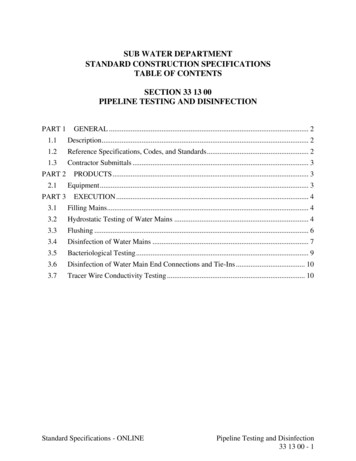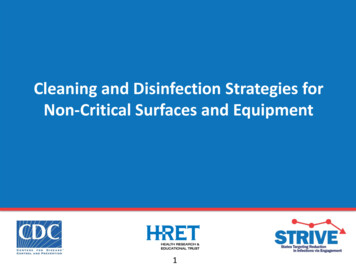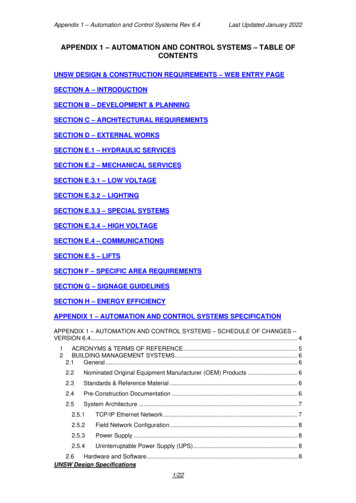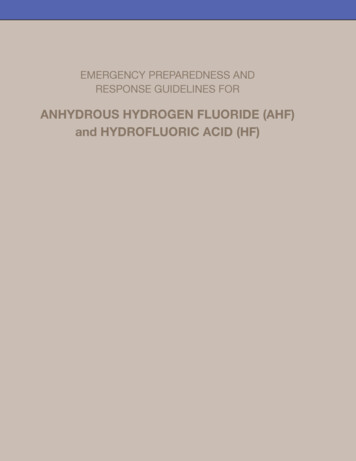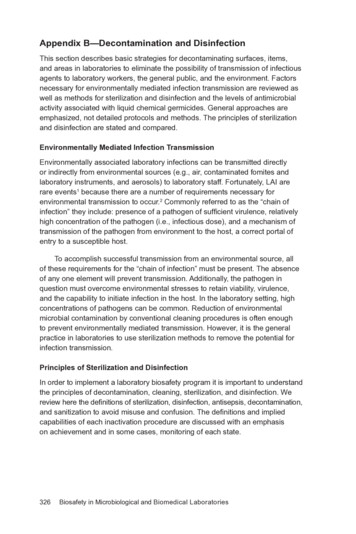
Transcription
Appendix B—Decontamination and DisinfectionThis section describes basic strategies for decontaminating surfaces, items,and areas in laboratories to eliminate the possibility of transmission of infectiousagents to laboratory workers, the general public, and the environment. Factorsnecessary for environmentally mediated infection transmission are reviewed aswell as methods for sterilization and disinfection and the levels of antimicrobialactivity associated with liquid chemical germicides. General approaches areemphasized, not detailed protocols and methods. The principles of sterilizationand disinfection are stated and compared.Environmentally Mediated Infection TransmissionEnvironmentally associated laboratory infections can be transmitted directlyor indirectly from environmental sources (e.g., air, contaminated fomites andlaboratory instruments, and aerosols) to laboratory staff. Fortunately, LAI arerare events1 because there are a number of requirements necessary forenvironmental transmission to occur.2 Commonly referred to as the “chain ofinfection” they include: presence of a pathogen of sufficient virulence, relativelyhigh concentration of the pathogen (i.e., infectious dose), and a mechanism oftransmission of the pathogen from environment to the host, a correct portal ofentry to a susceptible host.To accomplish successful transmission from an environmental source, allof these requirements for the “chain of infection” must be present. The absenceof any one element will prevent transmission. Additionally, the pathogen inquestion must overcome environmental stresses to retain viability, virulence,and the capability to initiate infection in the host. In the laboratory setting, highconcentrations of pathogens can be common. Reduction of environmentalmicrobial contamination by conventional cleaning procedures is often enoughto prevent environmentally mediated transmission. However, it is the generalpractice in laboratories to use sterilization methods to remove the potential forinfection transmission.Principles of Sterilization and DisinfectionIn order to implement a laboratory biosafety program it is important to understandthe principles of decontamination, cleaning, sterilization, and disinfection. Wereview here the definitions of sterilization, disinfection, antisepsis, decontamination,and sanitization to avoid misuse and confusion. The definitions and impliedcapabilities of each inactivation procedure are discussed with an emphasison achievement and in some cases, monitoring of each state.326Biosafety in Microbiological and Biomedical Laboratories
SterilizationAny item, device, or solution is considered to be sterile when it is completelyfree of all living microorganisms and viruses. The definition is categorical andabsolute (i.e., an item is either sterile or it is not). A sterilization procedure is onethat kills all microorganisms, including high numbers of bacterial endospores.Sterilization can be accomplished by heat, ethylene oxide gas, hydrogenperoxide gas, plasma, ozone, and radiation (in industry). From an operationalstandpoint, a sterilization procedure cannot be categorically defined. Rather, theprocedure is defined as a process, after which the probability of a microorganismsurviving on an item subjected to treatment is less than one in one million (10-6).This is referred to as the “sterility assurance level.” 3,4DisinfectionDisinfection is generally a less lethal process than sterilization. It eliminatesnearly all recognized pathogenic microorganisms but not necessarily all microbialforms (e.g., bacterial spores) on inanimate objects. Disinfection does not ensurean “overkill’’ and therefore lacks the margin of safety achieved by sterilizationprocedures. The effectiveness of a disinfection procedure is controlled significantlyby a number of factors, each one of which may have a pronounced effect on theend result. Among these are: the nature and number of contaminating microorganisms (especiallythe presence of bacterial spores); the amount of organic matter present (e.g., soil, feces, and blood); the type and condition of instruments, devices, and materials tobe disinfected; the temperature.Disinfection is a procedure that reduces the level of microbial contamination,but there is a broad range of activity that extends from sterility at one extreme to aminimal reduction in the number of microbial contaminants at the other. By definition,chemical disinfection and in particular, high-level disinfection differs from chemicalsterilization by its lack of sporicidal power. This is an over simplification of theactual situation because a few chemical germicides used as disinfectants do, infact, kill large numbers of spores even though high concentrations and severalhours of exposure may be required. Non-sporicidal disinfectants may differ intheir capacity to accomplish disinfection or decontamination. Some germicidesrapidly kill only the ordinary vegetative forms of bacteria such as staphylococciand streptococci, some forms of fungi, and lipid-containing viruses, whereasothers are effective against such relatively resistant organisms as Mycobacteriumtuberculosis var. bovis, non-lipid viruses, and most forms of fungi.Appendix B: Decontamination and Disinfection327
Spaulding ClassificationIn 1972, Dr. Earl Spaulding5 proposed a system for classifying liquid chemicalgermicides and inanimate surfaces that has been used subsequently by CDC,FDA, and opinion leaders in the United States. This system, as it applies todevice surfaces, is divided into three general categories based on the theoreticalrisk of infection if the surfaces are contaminated at time of use. From thelaboratory perspective, these categories are: critical—instruments or devices that are exposed to normally sterileareas of the body require sterilization; semi-critical—instruments or devices that touch mucous membranesmay be either sterilized or disinfected; non-critical—instruments or devices that touch skin or come intocontact with persons only indirectly can be either cleaned and thendisinfected with an intermediate-level disinfectant, sanitized with alow-level disinfectant, or simply cleaned with soap and water.In 1991, microbiologists at CDC proposed an additional category,environmental surfaces (e.g., floors, walls, and other “housekeeping surfaces”)that do not make direct contact with a person’s skin.6 Spaulding also classifiedchemical germicides by activity level:High-level DisinfectionThis procedure kills vegetative microorganisms and inactivates viruses, but notnecessarily high numbers of bacterial spores. Such disinfectants are capableof sterilization when the contact time is relatively long (e.g., 6 to 10 hours). Ashigh-level disinfectants, they are used for relatively short periods of time (e.g.,10 to 30 minutes). These chemical germicides are potent sporicides and, inthe United States, are classified by the FDA as sterilant/disinfectants. Theyare formulated for use on medical devices, but not on environmental surfacessuch as laboratory benches or floors.7Intermediate-level DisinfectionThis procedure kills vegetative microorganisms, including Mycobacteriumtuberculosis, all fungi, and inactivates most viruses. Chemical germicidesused in this procedure often correspond to Environmental Protection Agency(EPA)-approved “hospital disinfectants” that are also “tuberculocidal.” Theyare used commonly in laboratories for disinfection of laboratory benchesand as part of detergent germicides used for housekeeping purposes.328Biosafety in Microbiological and Biomedical Laboratories
Low-level DisinfectionThis procedure kills most vegetative bacteria except M. tuberculosis, some fungi,and inactivates some viruses. The EPA approves chemical germicides used inthis procedure in the US as “hospital disinfectants” or “sanitizers.”Decontamination in the Microbiology LaboratoryDecontamination in the microbiology laboratory must be carried out with greatcare. In this arena, decontamination may entail disinfection of work surfaces,decontamination of equipment so it is safe to handle, or may require sterilization.Regardless of the method, the purpose of decontamination is to protect thelaboratory worker, the environment, and anyone who enters the laboratory orhandles laboratory products away from the laboratory. Reduction of crosscontamination in the laboratory is an added benefit.Decontamination and CleaningDecontamination renders an area, device, item, or material safe to handle (i.e.,safe in the context of being reasonably free from a risk of disease transmission).The primary objective is to reduce the level of microbial contamination so thatinfection transmission is eliminated. The decontamination process may beordinary soap and water cleaning of an instrument, device, or area. In laboratorysettings, decontamination of items, spent laboratory materials, and regulatedlaboratory wastes is often accomplished by a sterilization procedure such assteam autoclaving, perhaps the most cost-effective way of decontaminating adevice or an item.The presence of any organic matter necessitates longer contact time witha decontamination method if the item or area is not pre-cleaned. For example,a steam cycle used to sterilize pre-cleaned items is 20 minutes at 121 C.When steam sterilization is used to decontaminate items that have a highbio-burden and there is no pre-cleaning (i.e., infectious waste) the cycle islonger. Decontamination in laboratory settings often requires longer exposuretimes because pathogenic microorganisms may be protected from contactwith the decontaminating agents.Appendix B: Decontamination and Disinfection329
Table 1. Descending Order of Resistance to Germicidal ChemicalsBacterial SporesBacillus subtilis, Clostridium sporogenes MycobacteriaMycobacterium tuberculosis var. bovis, Nontuberculous mycobacteria Nonlipid or Small VirusesPoliovirus, Coxsackievirus, Rhinovirus FungiTrichophyton spp., Cryptococcus spp., Candida spp. Vegetative BacteriaPseudomonas aeruginosa, Staphylococcus aureus, Salmonella choleraesuis,Enterococci Lipid or Medium-size VirusesHerpes simplex virus, CMV, Respiratory syncytial virus, HBV, HCV, HIV, Hantavirus,Ebola virusNote: There are exceptions to this list. Pseudomonas spp are sensitive tohigh-level disinfectants, but if they grow in water and form biofilms on surfaces,the protected cells can approach the resistance of bacterial spores to the samedisinfectant. The same is true for the resistance to glutaraldehyde by somenontuberculous mycobacteria, some fungal ascospores of Microascus cinereusand Cheatomium globosum, and the pink pigmented Methylobacteria. Prionsare also resistant to most liquid chemical germicides and are discussed in thelast part of this section.Chemical germicides used for decontamination range in activity from highlevel disinfectants (i.e., high concentrations of sodium hypochlorite [chlorinebleach]), which might be used to decontaminate spills of cultured or concentratedinfectious agents in research or clinical laboratories, to low-level disinfectantsor sanitizers for general housekeeping purposes or spot decontamination ofenvironmental surfaces in healthcare settings. Resistance of selected organismsto decontamination is presented in descending order in Table 1. If dangerousand highly infectious agents are present in a laboratory, the methods fordecontamination of spills, laboratory equipment, BSC, or infectious wasteare very significant and may include prolonged autoclave cycles, incinerationor gaseous treatment of surfaces.330Biosafety in Microbiological and Biomedical Laboratories
Decontamination of Large SpacesSpace decontamination is a specialized activity and should be performed byspecialists with proper training and protective equipment.8 Decontaminationrequirements for BSL-3 and BSL-4 laboratory space have an impact on thedesign of these facilities. The interior surfaces of BSL-3 laboratories must bewater resistant in order for them to be easily cleaned and decontaminated.Penetrations in these surfaces should be sealed or capable of being sealedfor decontamination purposes. Thus, in the BSL-3 laboratory, surfacedecontamination, not fumigation, is the primary means of decontaminatingspace. Care should be taken that penetrations in the walls, floors and ceilingsare kept to a minimum and are “sight sealed.” Verification of the seals is usuallynot required for most BSL-3 laboratories. The BSL-4 laboratory design requiresinterior surfaces that are water resistant AND sealed to facilitate fumigation.These seals must be tested and verified to ensure containment in order to permitboth liquid disinfection and fumigation. Periodic fumigation is required in theBSL-4 suit laboratory to allow routine maintenance and certification of equipment.Procedures for decontamination of large spaces such as incubators or roomsare varied and influenced significantly by the type of etiologic agent involved, thecharacteristics of the structure containing the space, and the materials presentin the space. The primary methods for space decontamination follow.Formaldehyde—ParaformaldehydeFormaldehyde gas at a concentration of 0.3 grams/cubic foot for four hours isoften used for space decontamination. Gaseous formaldehyde can be generatedby heating flake paraformaldehyde (0.3 grams per cubic foot) in a frying pan,thereby converting it to formaldehyde gas. The humidity must be controlled andthe system works optimally at 80% relative humidity. This method is effective inkilling microorganisms but toxicity issues are present.1,9 Additional information onenvironmental and safety issues related to paraformaldehyde is available fromthe EPA Web site: www.epa.gov/pesticides.Hydrogen Peroxide VaporHydrogen peroxide can be vaporized and used for the decontamination of gloveboxes as well as small room areas. Vapor phase hydrogen peroxide has beenshown to be an effective sporicide at concentrations ranging from 0.5 mg/L to 10 mg/L. The optimal concentration of this agent is about 2.4 mg/L with a contacttime of at least one hour. This system can be used to decontaminate glove boxes,walk in incubators and small rooms. An advantage of this system is that the endproducts (i.e., water) are not toxic. Low relative humidity can be used.10-14Chlorine Dioxide GasChlorine dioxide gas sterilization can be used for decontamination of laboratoryrooms, equipment, glove boxes, and incubators. The concentration of gas at theAppendix B: Decontamination and Disinfection331
site of decontamination should be approximately 10 mg/L with contact time ofone to two hours.Chlorine dioxide possesses the bactericidal, virucidal and sporicidalproperties of chlorine, but unlike chlorine, does not lead to the formation oftrihalomethanes or combine with ammonia to form chlorinated organic products(chloramines). The gas cannot be compressed and stored in high-pressurecylinders, but is generated upon demand using a column-based solid phasegeneration system. Gas is diluted to the use concentration, usually between10 and 30 mg/L. Within reasonable limits, a chlorine dioxide gas generationsystem is unaffected by the size or location of the ultimate destination for the gas.Relative humidity does need to be controlled and high humidities are optimal.Although most often used in closed sterilizers, the destination enclosure for thechlorine dioxide gas does not, in fact, need to be such a chamber. Becausechlorine dioxide gas exits the generator at a modest positive pressure and flowrate, the enclosure also need not be evacuated and could be a sterility-testingisolator, a glove box or sealed BSC, or even a small room that could be sealedto prevent gas egress.15 Chlorine dioxide gas is rapidly broken down by light;care must be taken to eliminate light sources in spaces to be decontaminated.Decontamination of SurfacesLiquid chemical germicides formulated as disinfectants may be used fordecontamination of large areas. The usual procedure is to flood the area witha disinfectant for periods up to several hours. This approach is messy and withsome of the disinfectants used represents a toxic hazard to laboratory staff. Forexample, most of the “high-level” disinfectants on the United States market areformulated to use on instruments and medical devices and not on environmentalsurfaces. Intermediate and low-level disinfectants are formulated to use on fomitesand environmental surfaces but lack the potency of a high-level disinfectant. Forthe most part intermediate and low level disinfectants can be safely used and, aswith all disinfectants, the manufacturer’s instructions should be closely followed.7Disinfectants that have been used for decontamination include sodium hypochloritesolutions at concentrations of 500 to 6000 parts per million (ppm), oxidativedisinfectants such as hydrogen peroxide and peracetic acid, phenols, and iodophors.Concentrations and exposure times vary depending on the formulation andthe manufacturer’s instructions for use.6,16 See Table 2 for a list of chemicalgermicides and their activity levels. A spill control plan must be available in thelaboratory. This plan should include the rationale for selection of the disinfectingagent, the approach to its application, contact time and other parameters. Agentsrequiring BSL-3 and BSL-4 containment pose a high risk to workers and possiblyto the environment and should be managed by well-informed professional stafftrained and equipped to work with concentrated material.332Biosafety in Microbiological and Biomedical Laboratories
Table 2. Activity Levels of Selected Liquid GermicidesaProcedure / ProductAqueous ConcentrationActivity LevelSterilizationglutaraldehydevariablehydrogen peroxide6 – 30%formaldehyde6 – 8%chlorine dioxidevariableperacetic acidDisinfectionglutaraldehydevariablehigh to intermediateortho-phthalaldehyde0.5%highhydrogen peroxide3 – 6%high to intermediateformaldehydebchlorine dioxideperacetic acidchlorine compoundscvariablehighIntermediatealcohols (ethyl, isopropyl) d70%Intermediatephenolic compounds0.5 to 3%intermediate to lowequaternary ammoniumcompoundsbhigh to lowhigh500 to 5000 ml/L free/availablechlorineciodophor compoundsa1 – 8%variable30 – 50 mg/L free iodine up to10,000 mg/L available iodine0.1 – 0.2%intermediate to lowlowThis list of chemical germicides centers on generic formulations. A large number ofcommercial products based on these generic components can be considered for use.Users should ensure that commercial formulations are registered with EPA or by the FDA.Because of the ongoing controversy of the role of formaldehyde as a potential occupationalcarcinogen, the use of formaldehyde is limited to certain specific circumstances undercarefully controlled conditions (e.g., for the disinfection of certain hemodialysis equipment).There are no FDA cleared liquid chemical sterilant/disinfectants that contain formaldehyde.Generic disinfectants containing chlorine are available in liquid or solid form (e.g., sodium orcalcium hypochlorite). Although the indicated concentrations are rapid acting and broadspectrum (tuberculocidal, bactericidal, fungicidal, and virucidal), no proprietary hypochloriteformulations are formally registered with EPA or cleared by FDA. Common householdbleach is an excellent and inexpensive source of sodium hypochlorite. Concentrationsbetween 500 and 1000 mg/L chlorine are appropriate for the vast majority of usesrequiring an intermediate level of germicidal activity; higher concentrations are extremelycorrosive as well as irritating to personnel, and their use should be limited to situationswhere there is an excessive amount of organic material or unusually high concentrationsof microorganisms (e.g., spills of cultured material in the laboratory).Appendix B: Decontamination and Disinfection333
deThe effectiveness of alcohols as intermediate level germicides is limited because theyevaporate rapidly, resulting in short contact times, and also lack the ability to penetrateresidual organic material. They are rapidly tuberculocidal, bactericidal and fungicidal, butmay vary in spectrum of virucidal activity (see text). Items to be disinfected with alcoholsshould be carefully pre-cleaned then totally submerged for an appropriate exposure time(e.g., 10 minutes).Only those iodophors registered with EPA as hard-surface disinfectants should be used,closely following the manufacturer’s instructions regarding proper dilution and productstability. Antiseptic iodophors are not suitable to disinfect devices, environmentalsurfaces, or medical instruments.Special Infectious Agent IssuesTransmissible Spongiform Encephalopathy Agents (Prions)The major exception to the rule in the previous discussion of microbialinactivation and decontamination is the causative agent of CJD or other prionagents responsible for transmissible spongiform encephalopathies of the centralnervous system in humans or animals. Studies show that prions are resistant toconventional uses of heat and/or chemical germicides for the sterilization ofinstruments and devices. (See Section IX.)References1.2.3.4.5.6.7.8.334Vesley D, Lauer J, Hawley R. Decontamination, sterilization, disinfection, andantisepsis. In: Fleming DO, Hunt DL, editors. Laboratory safety: principlesand practices. 3rd ed. Washington, DC: ASM Press; 2001. p. 383-402.Rhame FS. The inanimate environment. In: Bennett JV, Brachmann PS, editors.Hospital infections. 4th ed. Philadelphia: Lippincott-Raven; 1998. p. 299-324.Favero M. Developing indicators for sterilization. In: Rutala W, editor.Disinfection, sterilization and antisepsis in health care. Washington, DC:Association for Professionals in Infection Control and Epidemiology, Inc.;1998. p. 119-132.Favero M. Sterility assurance: concepts for patient safety. In: Rutala W,editor. Disinfection, sterilization and antisepsis: principles and practices inhealthcare facilities. Washington, DC: Association for Professionals inInfection Control and Epidemiology, Inc.; 2001. p. 110-9.Spaulding EH. Chemical disinfection and antisepsis in the hospital. J HospRes. 1972:9;5-31.Favero M, Bond W. Chemical disinfection of medical surgical material. In:Block S, editor. Disinfection, sterilization, and preservation. 5th edition.Philadelphia: Lippencott, Williams and Wilkens; 2001. p. 881-917.Centers for Disease Control and Prevention [www.cdc.gov]. Atlanta: TheCenters for Disease Control and Prevention; [updated 2006 Sept 21]. Guidelinesfor Environmental Infection Control in Health-Care Facilities, 2003; [about 2screens] Available from: http://www.cdc.gov/hicpac/pubs.htmlTearle P. Decontamination by fumigation. Commun Dis Public Health.2003;6:166-8.Biosafety in Microbiological and Biomedical Laboratories
9.10.11.12.13.14.15,16.Fink R, Liberman DF, Murphy K, et al. Biological safety cabinets,decontamination or sterilization with paraformaldehyde. Am Ind Hyg AssocJ. 1988;49:277-9.Klapes NA, Vesley D. Vapor-phase hydrogen peroxide as a surfacedecontaminant and sterilant. Appl Environ Microbiol. 1990;56:503-6.Graham GS, Rickloff JR. Development of VHP sterilization technology.J Healthc Mater Manage. 1992;54:56-8.Johnson JW, Arnold JF, Nail SL, et al. Vaporized hydrogen peroxidesterilization of freeze dryers. J Parenter Sci Technol. 1992;46:215-25.Heckert RA, Best M, Jordan LT, et al. Efficacy of vaporized hydrogenperoxide against exotic animal viruses. Appl Environ Microbiol.1997;63:3916-8.Krause J, McDonnell G, Riedesel H. Biodecontamination of animal roomsand heat-sensitive equipment with vaporized hydrogen peroxide. ContempTop Lab Anim Sci. 2001;40:18-21.Knapp JE, Battisti DL. Chlorine Dioxide. In: Block S, editor. Disinfection,sterilization, and preservation. 5th ed. Philadelphia: Lippencott, Williamsand Wilkens; 2001. p. 215-27.Weber DJ, Rutala WA. Occupational risks associated with the use ofselected disinfectants and sterilants. In: Rutala WA, editor. Disinfection,sterilization and antisepsis in health care. Champlain (NY): PolysciencePublications: 1998 p. 211-26.Appendix B: Decontamination and Disinfection335
326 Biosafety in Microbiological and Biomedical Laboratories Appendix B—Decontamination and Disinfection This section describes basic strategies for decontaminating surfaces, items, and areas in laboratories to eliminate the possibility of transmission of infectious agents to laboratory workers, the general public, and the environment. Factors

